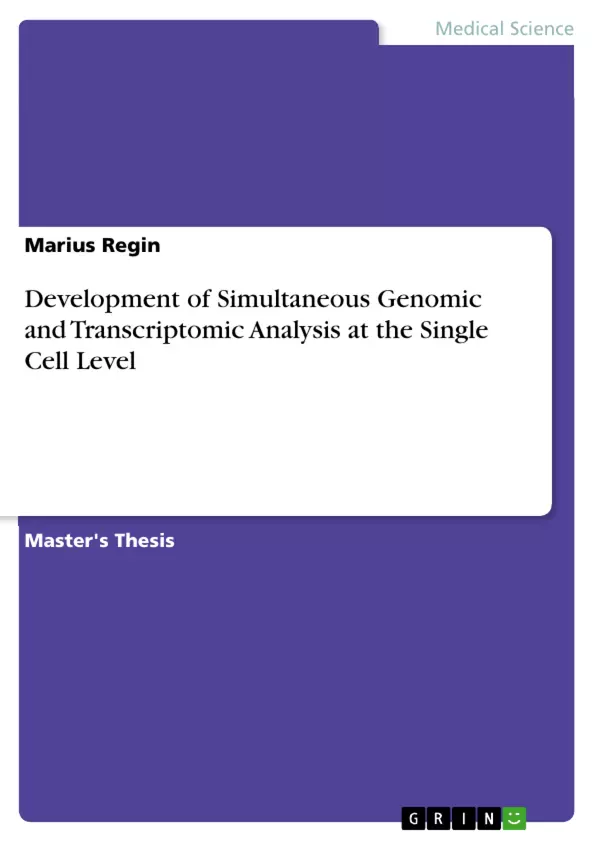In this master thesis, we want to develop and implement simultaneous genome and transcriptome analysis at the single cell level, through analyzing single cells of human embryonic stem cells and human fibroblasts. For the validation of the experiments we used (1) purified RNA & DNA mixes, (2) larger numbers of cells and (3) dilutions down to one single cell.
The ultimate goal of using such technique is to investigate each single blastomere of human embryos at the two- to eight-cell stage. We particularly want to investigate the hypothesis whether shortage of previously mentioned transcripts leads to an abnormal number of chromosomes during embryonal development.
Roughly half of the human preimplantation embryos obtained after in vitro fertilization (IVF) and intracytoplasmic sperm injection (ICSI) show a high frequency of chromosomal mosaicism, the event where not all cells of an embryo display an identical chromosomal composition. These abnormalities are mostly explained by anaphase lagging, non-disjunction and endoreduplication, of which anaphase lagging is the most common mechanism resulting in mosaicism.
They originate during postzygotic, mitotic divisions. Several authors hypothesize that the causes of the aberrations lie in the depletion of certain transcripts such as for the components of the chromosomal passenger complex (CPC) and the spindle attachment checkpoint (SAC) which are key regulators during cell division that correct chromosome attachment errors and prevent chromosome mis-segregations and aneuploidy.
Conversely, transcriptome analysis on whole embryos has shown the presence of these transcripts which argues against their role during the development of aneuploidies. Interestingly, different SAC and CPC expression levels were shown at the single cell level, but without correlation to chromosomal abnormalities.
Inhaltsverzeichnis (Table of Contents)
- SUMMARY
- SAMENVATTING
- INTRODUCTION
- ASSISTED REPRODUCTIVE TECHNOLOGIES
- PREIMPLANTATION GENETIC TESTING
- PGT FOR MONOGENIC/SINGLE GENE DEFECT (PGT-M)
- PGT FOR ANEUPLOIDIES (PGT-A)/STRUCTURAL REARRANGEMENTS (PGT-SR)
- FLUORESCENCE IN SITU HYBRIDIZATION FOR SINGLE CELL ANALYSIS
- COMPREHENSIVE CHROMOSOME SCREENING
- NEXT GENERATION SEQUENCING
- THE ORIGIN OF CHROMOSOMAL ABNORMALITIES IN PREIMPLANTATION EMBRYOS
- ORIGIN OF MITOTIC ANEUPLOIDIES
- UNDERLYING PROCESSES LEADING TO ABNORMAL CHROMOSOME NUMBERS
- MATERNAL FACTORS AFFECTING MITOTIC ANEUPLOIDIES
- THE SPINDLE ASSEMBLY CHECKPOINT DURING MITOSIS
- THE CHROMOSOMAL PASSENGER COMPLEX
- OBJECTIVES OF THE MASTER THESIS
- MATERIALS AND METHODS
- CELL CULTURE
- RNA/DNA EXTRACTION
- SINGLE CELL PICK-UP
- CDNA SYNTHESIS
- CDNA AMPLIFICATION
- PHYSICAL SEPARATION OF MRNA AND GDNA
- MEASURING CDNA CONCENTRATIONS
- GENOMIC DNA PRECIPITATION AND AMPLIFICATION
- QUANTITATIVE REAL-TIME PCR (QRT-PCR)
- PCR
- RESULTS
- VALIDATION OF THE OLIGO-DT 30VN PRIMER SET
- BULK RNA FIBROBLASTS
- BULK RNA HESC
- VALIDATION OF THE TSO AND ISPCR PRIMER SET
- IMPLEMENTATION OF OLIGO-DT 30VN LABELLED MAGNETIC BEADS
- RNA DILUTION SERIES
- SINGLE CELL LEVEL
- VALIDATION OF THE CFTR PRIMER SET
- DNA DILUTION
- SINGLE CELL LEVEL
- VALIDATION OF PHYSICAL SEPARATION OF MRNA AND GDNA
- RNA/DNA MIXES
- VALIDATION OF AMPLIFIED CDNA
- VALIDATION OF AMPLIFIED GDNA AFTER MULTIPLE DISPLACEMENT AMPLIFICATION
- SINGLE CELL LEVEL
- VALIDATION OF AMPLIFIED CDNA
- VALIDATION OF AMPLIFIED GDNA AFTER MULTIPLE DISPLACEMENT AMPLIFICATION
- VALIDATION OF THE PICOPLEX WGA KIT
- VALIDATION OF AMPLIFIED GDNA AFTER PICOPLEX
- SHALLOW WHOLE GENOME SEQUENCING DATA
- RNA/DNA MIXES
- VALIDATION OF THE OLIGO-DT 30VN PRIMER SET
- DISCUSSION
- CONCLUSION
- ACKNOWLEDGEMENTS
- ABBREVIATIONS
- REFERENCES
Zielsetzung und Themenschwerpunkte (Objectives and Key Themes)
This master thesis aims to develop and implement simultaneous genome and transcriptome analysis at the single cell level, by analyzing single cells of human embryonic stem cells and human fibroblasts. The goal is to investigate the hypothesis whether shortage of specific transcripts leads to an abnormal number of chromosomes during embryonal development. The thesis explores the potential of this technique to investigate each single blastomere of human embryos at the two- to eight-cell stage, potentially identifying novel markers for genetic health and increasing the efficiency of IVF in the future.
- Chromosomal mosaicism in preimplantation embryos
- Role of specific transcripts in chromosome segregation
- Development and implementation of single-cell genome and transcriptome analysis
- Validation of the technique using different cell types and dilutions
- Potential applications in IVF and genetic health assessment
Zusammenfassung der Kapitel (Chapter Summaries)
The introduction provides background information on assisted reproductive technologies, preimplantation genetic testing, and the origin of chromosomal abnormalities in preimplantation embryos. It explores the role of specific transcripts, such as those for the chromosomal passenger complex (CPC) and the spindle attachment checkpoint (SAC), in preventing chromosome mis-segregations and aneuploidy.
The materials and methods chapter describes the experimental procedures, including cell culture, RNA/DNA extraction, single cell pick-up, cDNA synthesis, cDNA amplification, physical separation of mRNA and gDNA, measuring cDNA concentrations, genomic DNA precipitation and amplification, and quantitative real-time PCR (qRT-PCR).
The results section presents the validation of the oligodT-primer, TSO and ISPCR primer, demonstrating successful conversion of RNA from hESC and fibroblasts into cDNA and subsequent amplification. The implementation of physical separation of mRNA and gDNA is also detailed, along with the successful measurement of cDNA and gDNA amounts after amplification. The chapter concludes with the detection of known chromosomal abnormalities in two single cells from an abnormal hESC line using shallow whole genome sequencing (WGS) after Picoplex.
Schlüsselwörter (Keywords)
Preimplantation genetic testing, chromosomal mosaicism, aneuploidy, single-cell analysis, genome, transcriptome, embryonic stem cells, fibroblasts, IVF, genetic health, biomarkers.
- Quote paper
- Marius Regin (Author), 2018, Development of Simultaneous Genomic and Transcriptomic Analysis at the Single Cell Level, Munich, GRIN Verlag, https://www.grin.com/document/490849



